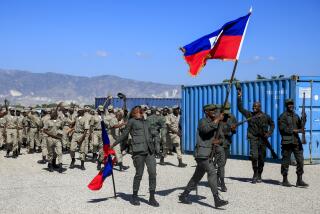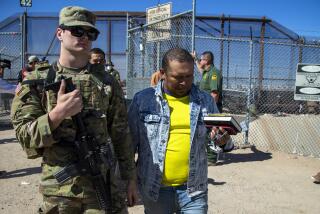CRISIS IN THE CARIBBEAN : Invasion-Ready Brigade Now Bides Its Time : Military: Clinton’s decision to change mission left signal unit scrambling for new orders.
- Share via
PUERTO PLATA, Dominican Republic — It’s a good thing the Army was not counting exclusively on its 35th Signal Brigade to make Haiti safe for democracy.
First, the 35th, like most of the U.S. forces preparing to invade Haiti, was whipsawed between readiness and anticlimax: On Sunday night, with some U.S. warplanes and paratroopers already in the air, a delegation led by former President Jimmy Carter reached an agreement with Haiti’s military leaders that headed off the invasion.
That turned the U.S. invasion force into an occupation force. Except for the 35th, that is. After two aborted landing attempts, one caused by a thunderstorm and the other by mechanical failure, the 330 members of the 35th found themselves stuck Tuesday in this provincial town in the Dominican Republic, itching for action and increasingly frustrated.
One officer used baseball lingo to describe the way the Haiti invasion unfolded for the 35th Brigade as “a checked swing.”
And more than the 35th was affected. With the 35th’s officers and equipment sitting on a runway in this resort town, military communications inside Haiti were seriously deficient for the first 24 hours of the occupation.
Only three days earlier, the 35th had been looking forward to a major role in the invasion. In a windowless building in the heart of Ft. Bragg, N.C., on Saturday afternoon, Col. James David Bryan called together the unit’s officers for one last run-through of their marching orders.
For 2 1/2 hours, the brigade’s staff pored over the complex details of their plans, months in the making, to rush 750 men, their vehicles and tons of high-tech gear to achieve their objective: establishing the main communications network of the military’s joint command in Haiti overnight.
Twenty-four hours later, just as the first elements of the brigade were ready to move to their aircraft for the flight to Haiti, they received the order to stand down.
It quickly became clear that Clinton’s decision to halt the invasion had left military units scrambling to determine what their new missions would be, even though staff officers insisted that they had been working on contingency plans for a peaceful entry into Haiti since June.
Now the division and units scheduled to follow the paratroopers into Haiti found their roles changed radically. Commanders at Ft. Bragg had to switch to an alternate plan that called for a much smaller force led by the 10th Mountain Division.
Units from the division reached Haiti by helicopter early Monday from aircraft carriers off the Haitian coast. But for the officers and troops of the 35th Signal Brigade, as for many other units throughout the planned invasion force, Monday was a day of waiting and confusion. Thousands of troops at Ft. Bragg found themselves riding a giant military beast as it slowly changed direction, and they turned within for the stoic patience so often required to survive Army life.
In a battalion headquarters ready room, men from the 35th’s 50th battalion were left in isolation, loaded down with all their gear, unsure of their status, and watching CNN on a big-screen television to see units of the 10th Mountain Division land in Haiti.
“I guess not knowing when or if we are going, that is the hard part,” said Sgt. Chad Patton from Costa Mesa.
“We want to go or not go,” added Lt. John Holmes.
By late Monday afternoon only a handful of officers and men from the 35th were on their way, aboard one of the first aircraft ferrying troops from Ft. Bragg.
Maj. Brian Hurley said that, after a series of hurried planning meetings, the brigade had cut back the size of its Haiti-bound force to about 250, down from the initial 750.
As they reorganized their unit, brigade commanders fretted about the equipment and vehicles they had already sent to cargo ships now waiting to dock in Port-au-Prince. Figuring out how to unload only the equipment designated for those units still headed for Haiti posed a fresh logistics nightmare.
“Since things have changed, what we have to do is try to put together a communications network with what we got going now,” said Maj. Mark Mabima, a brigade spokesman.
More to Read
Sign up for Essential California
The most important California stories and recommendations in your inbox every morning.
You may occasionally receive promotional content from the Los Angeles Times.













